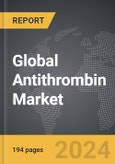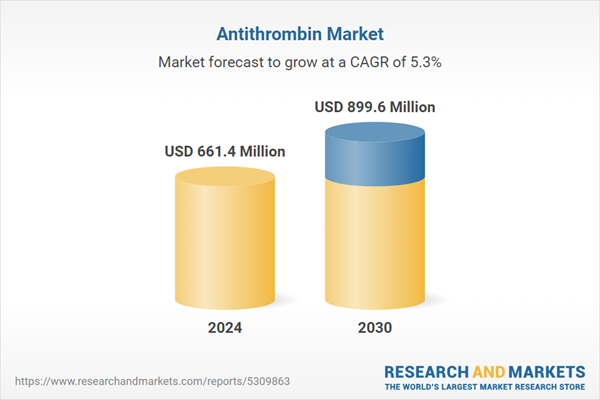The global market for Antithrombin was valued at US$661.4 Million in 2024 and is projected to reach US$899.6 Million by 2030, growing at a CAGR of 5.3% from 2024 to 2030. This comprehensive report provides an in-depth analysis of market trends, drivers, and forecasts, helping you make informed business decisions. The report includes the most recent global tariff developments and what they mean for your business.
Segments: Application (Therapeutics, Research, Diagnostics); Dosage Form (Lyophilized, Liquid); Source (Human, Goat Milk, Other Sources).
Geographic Regions/Countries: World; United States; Canada; Japan; China; Europe (France; Germany; Italy; United Kingdom; and Rest of Europe); Asia-Pacific; Rest of World.
The analysts continuously track trade developments worldwide, drawing insights from leading global economists and over 200 industry and policy institutions, including think tanks, trade organizations, and national economic advisory bodies. This intelligence is integrated into forecasting models to provide timely, data-driven analysis of emerging risks and opportunities.
Global Antithrombin Market - Key Trends & Drivers Summarized
Why Is Antithrombin Critical in Managing Blood Clotting Disorders?
Antithrombin plays a vital role in the regulation of blood coagulation, making it an essential therapeutic agent for the prevention and treatment of thrombotic disorders such as deep vein thrombosis, pulmonary embolism, and inherited antithrombin deficiencies. The increasing prevalence of cardiovascular diseases and blood clotting disorders, driven by aging populations and sedentary lifestyles, is propelling the demand for antithrombin-based therapies. As a naturally occurring protein in the body that inhibits clot formation, antithrombin is used in a variety of clinical settings, including during surgeries, childbirth, and in patients undergoing anticoagulant therapy. The rise in the number of surgeries, particularly in cardiovascular and orthopedic fields, is further driving the need for antithrombin to reduce the risk of post-operative thrombosis.How Is Biotechnology Enhancing Antithrombin Production and Applications?
The advancement of biotechnological processes has revolutionized the production and application of antithrombin, particularly with the development of recombinant antithrombin. Traditionally derived from human plasma, antithrombin production has faced challenges such as limited supply and the risk of contamination with blood-borne pathogens. However, recombinant technologies, which involve the use of genetically modified organisms such as goats to produce antithrombin in milk, have significantly increased production capacity while ensuring safety and consistency. These advancements have enabled the development of antithrombin therapies that are free from human or animal pathogen risks, thus expanding their use in a broader range of clinical applications, including rare genetic disorders and surgical settings. The potential for recombinant antithrombin to be used in novel therapies for conditions like sepsis and organ transplantation is also driving research and development in this area.What Regulatory Standards Are Shaping the Antithrombin Market?
As a biologically derived therapeutic, antithrombin is subject to strict regulatory oversight to ensure its safety and efficacy. Regulatory agencies such as the FDA, EMA, and PMDA have stringent requirements for the approval of antithrombin products, particularly concerning their purity, potency, and manufacturing processes. The shift towards recombinant antithrombin production has introduced additional regulatory complexities, as the use of transgenic animals and novel production methods requires thorough evaluation to ensure compliance with biosafety and ethical standards. Furthermore, ongoing monitoring of antithrombin therapies post-market is essential to detect any adverse events related to clotting abnormalities or allergic reactions. As more countries emphasize regulatory alignment and patient safety, manufacturers are focusing on achieving global standards for their antithrombin products, ensuring wider acceptance and adoption.What Factors Are Driving the Growth of the Antithrombin Market?
The growth in the antithrombin market is driven by several factors, including the rising incidence of cardiovascular and thrombotic disorders, increased surgical procedures, and advancements in biotechnology. The global aging population, which is more susceptible to clotting disorders, is a key driver of the market. Additionally, the development of recombinant antithrombin has addressed supply constraints and safety concerns associated with plasma-derived antithrombin, leading to greater adoption in medical treatments. The expansion of healthcare infrastructure in emerging markets is also boosting demand, as awareness of clotting disorders and access to advanced therapies improve. Furthermore, the increasing use of antithrombin in off-label applications, such as in sepsis treatment and organ transplantation, is creating new opportunities for market growth.Report Scope
The report analyzes the Antithrombin market, presented in terms of units. The analysis covers the key segments and geographic regions outlined below.Segments: Application (Therapeutics, Research, Diagnostics); Dosage Form (Lyophilized, Liquid); Source (Human, Goat Milk, Other Sources).
Geographic Regions/Countries: World; United States; Canada; Japan; China; Europe (France; Germany; Italy; United Kingdom; and Rest of Europe); Asia-Pacific; Rest of World.
Key Insights:
- Market Growth: Understand the significant growth trajectory of the Therapeutics segment, which is expected to reach US$847.5 Million by 2030 with a CAGR of a 5.4%. The Research segment is also set to grow at 3.4% CAGR over the analysis period.
- Regional Analysis: Gain insights into the U.S. market, valued at $181.9 Million in 2024, and China, forecasted to grow at an impressive 5.0% CAGR to reach $142.2 Million by 2030. Discover growth trends in other key regions, including Japan, Canada, Germany, and the Asia-Pacific.
Why You Should Buy This Report:
- Detailed Market Analysis: Access a thorough analysis of the Global Antithrombin Market, covering all major geographic regions and market segments.
- Competitive Insights: Get an overview of the competitive landscape, including the market presence of major players across different geographies.
- Future Trends and Drivers: Understand the key trends and drivers shaping the future of the Global Antithrombin Market.
- Actionable Insights: Benefit from actionable insights that can help you identify new revenue opportunities and make strategic business decisions.
Key Questions Answered:
- How is the Global Antithrombin Market expected to evolve by 2030?
- What are the main drivers and restraints affecting the market?
- Which market segments will grow the most over the forecast period?
- How will market shares for different regions and segments change by 2030?
- Who are the leading players in the market, and what are their prospects?
Report Features:
- Comprehensive Market Data: Independent analysis of annual sales and market forecasts in US$ Million from 2024 to 2030.
- In-Depth Regional Analysis: Detailed insights into key markets, including the U.S., China, Japan, Canada, Europe, Asia-Pacific, Latin America, Middle East, and Africa.
- Company Profiles: Coverage of players such as CSL Behring, Grifols International SA, Kedrion SpA, Lee Biosolutions, Inc., LFB SA and more.
- Complimentary Updates: Receive free report updates for one year to keep you informed of the latest market developments.
Some of the 41 companies featured in this Antithrombin market report include:
- CSL Behring
- Grifols International SA
- Kedrion SpA
- Lee Biosolutions, Inc.
- LFB SA
- Scripps Laboratories
- Shire PLC
Tariff Impact Analysis: Key Insights for 2025
Global tariff negotiations across 180+ countries are reshaping supply chains, costs, and competitiveness. This report reflects the latest developments as of April 2025 and incorporates forward-looking insights into the market outlook.The analysts continuously track trade developments worldwide, drawing insights from leading global economists and over 200 industry and policy institutions, including think tanks, trade organizations, and national economic advisory bodies. This intelligence is integrated into forecasting models to provide timely, data-driven analysis of emerging risks and opportunities.
What’s Included in This Edition:
- Tariff-adjusted market forecasts by region and segment
- Analysis of cost and supply chain implications by sourcing and trade exposure
- Strategic insights into geographic shifts
Buyers receive a free July 2025 update with:
- Finalized tariff impacts and new trade agreement effects
- Updated projections reflecting global sourcing and cost shifts
- Expanded country-specific coverage across the industry
Table of Contents
I. METHODOLOGYII. EXECUTIVE SUMMARY2. FOCUS ON SELECT PLAYERSIII. MARKET ANALYSISIV. COMPETITION
1. MARKET OVERVIEW
3. MARKET TRENDS & DRIVERS
4. GLOBAL MARKET PERSPECTIVE
UNITED STATES
CANADA
JAPAN
CHINA
EUROPE
FRANCE
GERMANY
ITALY
UNITED KINGDOM
REST OF EUROPE
ASIA-PACIFIC
REST OF WORLD
Companies Mentioned (Partial List)
A selection of companies mentioned in this report includes, but is not limited to:
- CSL Behring
- Grifols International SA
- Kedrion SpA
- Lee Biosolutions, Inc.
- LFB SA
- Scripps Laboratories
- Shire PLC
Table Information
| Report Attribute | Details |
|---|---|
| No. of Pages | 194 |
| Published | April 2025 |
| Forecast Period | 2024 - 2030 |
| Estimated Market Value ( USD | $ 661.4 Million |
| Forecasted Market Value ( USD | $ 899.6 Million |
| Compound Annual Growth Rate | 5.3% |
| Regions Covered | Global |









